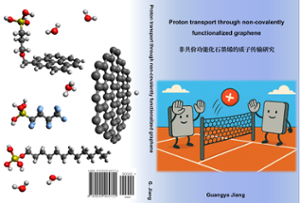Proefschrift
Proton transport through non-covalently functionalized graphene
Single-layer graphene (SLG) has attracted considerable interest as a proton exchange membrane for direct methanol fuel cells (DMFCs), owing to its atomic thickness, mechanical robustness, and unique proton permeability.
- Auteur
- G. Jiang
- Datum
- 21 oktober 2025
- Links
- Thesis in Leiden Repository

However, reliable evaluation of its transport properties and effective integration into practical membranes remain challenging.Reliable measurements require eliminating artifacts from bare Ag/AgCl electrodes, where AgCl particle deposition distorts intrinsic proton transport signals. With improved methods, it becomes clear that graphene’s proton conductivity is highly sensitive to interfacial chemistry. Asymmetric Nafion coatings induce a diode-like transport effect, while non-covalent functionalization with sodium dodecyl sulfate (SDS) or pyrene-based sulfonate (PMPS) introduces dense proton-conductive groups at the graphene interface. SDS-functionalized graphene/Nafion membranes reach power densities up to 68 mW cm-2 in DMFCs, surpassing pristine graphene and conventional Nafion membranes, while PMPS enables direct quantification of sulfonate density versus conductivity.These findings establish interfacial regulation as a structurally preserving yet highly effective strategy to enhance proton transport through graphene. The principles extend to broader electrochemical and separation technologies, including hydrogen fuel cells, redox flow batteries, and isotope separation.
